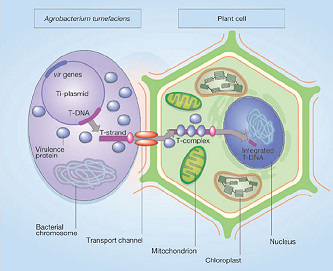How nature produces GM plants
Scientists have finally discovered how Agrobacterium tumefaciens incorporates its bacterial DNA into a plant’s genome – a natural form of genetic engineering.
I’d like to share with you an interesting new discovery in the world of plant science that follows on from my previous post about GM canola.
It relates very much to the current debate about genetic engineering; specifically one of the ways in which we plant scientists transform (or genetically engineer) plants.
The story goes back to 1977 when plant scientist Mary-Dell Chilton and colleagues at the University of Washington made a revolutionary discovery; that “genetic engineering” actually occurred in nature (contrary to popular belief).
More specifically, Chilton demonstrated that Agrobacterium tumefaciens caused Crown Gall Disease in plants by incorporating a part of its own DNA (called T-DNA) into the genome of the host plant via a Ti plasmid. This genetic change caused the infected plant to produce nutrients for the bacterium.

Agrobacterium tumefaciens infecting a plant cell. Click on image for more details. (© Nature Publishing Group)
Fast forward to 2007, and A. tumefaciens is frequently used in laboratories to genetically manipulate plants.
The virulence part of the bacteria’s Ti plasmid – the portion that causes the gall disease – is substituted by scientists for a desirable trait such as drought or herbicide resistance. The plant is then deliberately infected with the bacterium and a new gene is inserted into the plant.
Yet despite the frequent use of A. tumefaciens in laboratories, no-one actually understood how it was that the bacterium could get its DNA into the plant’s nucleus and not be detected by the plant’s defences.
Infecting Plants
The steps towards infection by Agrobacterium have been known for years.
The Agrobacterium comes into contact with a plant cell, and a single-stranded copy of T-DNA is passed into the cell, along with virulence (vir) proteins. The VirD2 protein is attached to one end of the T-DNA and assists its passage into the cell. The bacterium also inserts the VirE2 protein into the target cell, and with the assistance of karyopherin α the T-DNA is transferred into the plant’s nucleus (where its DNA is kept).
What wasn’t previously understood is how it was possible for the T-DNA to be carried into the nucleus past all the plant’s defences.
Solving the Mystery
Armin Djamei and Heribert Hirt at the University of Vienna have shown how the A. tumefaciens bacterium tricks the plant’s defence system and why the plant’s own VIP1 protein was the key to solving the mystery of T-DNA insertion.
When a plant is infected with A. tumefaciens, MAPK genes are activated. These cause the phosphorylation of VIP1 and other defence-related proteins, allowing them to enter the nucleus.
The VirE2 protein which the Agrobacterium injected into the plant cell simply allows the T-DNA to bind to the VIP1 protein, enabling those foreign genes to infiltrate the nucleus undetected. Once the genes are inside the nucleus, they are incorporated into the genome.
So in effect, the T-DNA enters the plant cell nucleus by utilising VIP1 as a Trojan Horse!
This finding is significant because Agrobacterium-mediated transformation is the most common method for producing GM plants, and therefore its comprehension is beneficial to plant science and plant pathology.
This also shows that with good research and patience, even the most elusive of biological processes can be understood in due time. I think these biological discoveries are fascinating as we learn more and more about the world around us.
Scientific References:
Binns, A.N. (2002) T-DNA of Agrobacterium tumefaciens: 25 years and counting. Trends in Plant Science 7 (5): 231-233
Chilton, M.D. et al. (1977) Stable incorporation of plasmid DNA into higher plant cells: the molecular basis of crown gall tumorigenesis. Cell 11: 263–271.
Djamei, A. et al. (2007) Trojan Horse strategy in Agrobacterium transformation: Abusing MAPK defence signalling. Science 318 (5849): 453-456
Snow, A. (2003) Genetic engineering: Unnatural selection. Nature 424: 619
Comments
No comments have yet been submitted. Be the first!